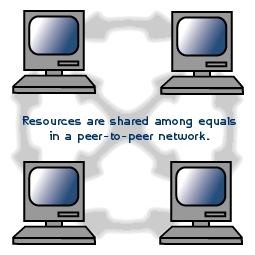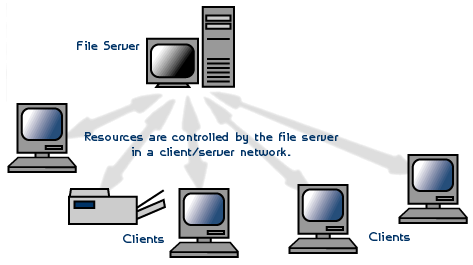What is a Network Operating System?
Unlike operating systems, such as Windows, that are designed for single users to control one computer, network operating systems (NOS) coordinate the activities of multiple computers across a network. The network operating system acts as a director to keep the network running smoothly.
The two major types of network operating systems are:
Nearly all modern networks are a combination of both. The networking design can be considered independent of the servers and workstations that will share it.
Peer-to-Peer
Peer-to-peer network operating systems allow users to share resources and files located on their computers and to access shared resources found on other computers. However, they do not have a file server or a centralized management source (See fig. 1). In a peer-to-peer network, all computers are considered equal; they all have the same abilities to use the resources available on the network. Peer-to-peer networks are designed primarily for small to medium local area networks. Nearly all modern desktop operating systems, such as Macintosh OSX, Linux, and Windows, can function as peer-to-peer network operating systems.

Fig. 1. Peer-to-peer network
Advantages of a peer-to-peer network:
- Less initial expense - No need for a dedicated server.
- Setup - An operating system (such as Windows XP) already in place may only need to be reconfigured for peer-to-peer operations.
Disadvantages of a peer-to-peer network:
- Decentralized - No central repository for files and applications.
- Security - Does not provide the security available on a client/server network.
Client/Server
Client/server network operating systems allow the network to centralize functions and applications in one or more dedicated file servers (See fig. 2). The file servers become the heart of the system, providing access to resources and providing security. Individual workstations (clients) have access to the resources available on the file servers. The network operating system provides the mechanism to integrate all the components of the network and allow multiple users to simultaneously share the same resources irrespective of physical location. UNIX/Linux and the Microsoft family of Windows Servers are examples of client/server network operating systems.

Fig. 2. Client/server network
Advantages of a client/server network:
- Centralized - Resources and data security are controlled through the server.
- Scalability - Any or all elements can be replaced individually as needs increase.
- Flexibility - New technology can be easily integrated into system.
- Interoperability - All components (client/network/server) work together.
- Accessibility - Server can be accessed remotely and across multiple platforms.
Disadvantages of a client/server network:
- Expense - Requires initial investment in dedicated server.
- Maintenance - Large networks will require a staff to ensure efficient operation.
- Dependence - When server goes down, operations will cease across the network.
Network Operating System Software
The following links include some of the more popular peer-to-peer and client/server network operating systems.